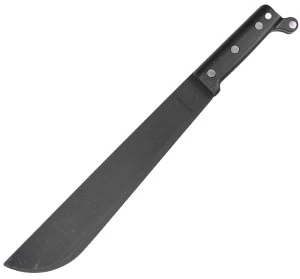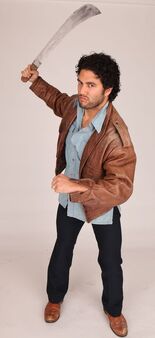(Adding categories) |
No edit summary |
||
| (37 intermediate revisions by 18 users not shown) | |||
| Line 1: | Line 1: | ||
| − | [[File: |
+ | [[File:Machete-1-.jpg|thumb|300px|right]] |
| − | The Machete is a large cleaver-like cutting tool often used as a weapon. It was the Close-Range weapon of the [[Medellin Cartel]]. |
+ | The Machete is a large cleaver-like cutting tool often used as a weapon. It was the Close-Range weapon of the [[Medellin Cartel]]. The [[Bolo Knife]], [[Cane Knife]] and [[Kukri]] are machetes of different designs. |
==Description== |
==Description== |
||
| − | The Machete has a long metal blade attached to an often wooden handle. The blade is usually straight with a single cutting edge. |
+ | The Machete has a long metal blade attached to an often wooden handle. The blade is usually straight with a single cutting edge.[[File:Medellin_1.jpg|thumb|155px|A Medellin Cartel thug with his machete]] |
| + | ===Stats=== |
||
| + | *2 foot blade |
||
| + | *1.5 lbs |
||
| + | *Wood & steel |
||
| + | |||
==Use== |
==Use== |
||
| − | In many tropical nations, it is used for cutting through undergrowth or for agricultural purposes, and may be used for a variety of oddjobs. Because it is common, it is often associated with uprisings and criminal organizations. |
+ | In many tropical nations, it is used for cutting through undergrowth or for agricultural purposes, and may be used for a variety of oddjobs. Because it is common, it is often associated with uprisings and criminal organizations. Machetes exist in almost every nation, even those with strict laws against carrying weapons. |
| + | |||
| + | Machetes and [[Cane Knife|Cane Knives]] were vital in the Haitian Revolution due to the enslaved working primarily agricultural tasks. While the slave population heavily outnumbered the French; the majority of slave revolutionaries had no guns while the French troops had arsenals akin to what they used during the Napoleonic Wars in Europe. It is estimated that only 20% of all Haitian rebels had a firearm of any kind. Haitians developed Machete martial arts to fight the French, and Haiti still have some practitioners of the art today [https://youtu.be/7p_NUEn7F_g]. |
||
| + | |||
| + | Most armies today have access to machetes for infiltrating areas of dense vegetation like forests or jungles; although some [[E-Tool]]s are equipped to perform similar tasks while offering a larger variety of uses. The Vietnam War saw widespread use of Machetes and Cane Knives by both sides in order to both travel through the jungle and to fight. |
||
| + | |||
| + | Machetes have been infamously used in acts of mass murder and genocide by criminals and governments alike. Jean-Jacques Dessalines led the 1804 Hatian Genocide with swords, bayonets and knives because he wanted the killings to be relatively quiet and avoided loud gunfire. Many drug cartels mutilate the corpses of their victims as psychological warfare. The "Colombian Necktie" involves the victim having their neck cut open and their tongue pulled through the wound. The Rwandan and Cambodian genocides also saw common use of machetes. |
||
| + | |||
| + | ==Trivia== |
||
| + | The nation of Angola has a machete on its national flag. |
||
[[Category:Weapons]] |
[[Category:Weapons]] |
||
| + | [[Category:Modern Weapons]] |
||
| + | [[Category:Swords]] |
||
| + | [[Category:Close Range Weapons]] |
||
| + | [[Category:Improvised Weapons]] |
||
| + | [[Category:Edge Weapons]] |
||
[[Category:Knives and Daggers]] |
[[Category:Knives and Daggers]] |
||
| + | [[Category:Weapons Used By Multiple Warriors]] |
||
| + | [[Category:Win and Lose Weapons]] |
||
Latest revision as of 01:46, 3 July 2020

The Machete is a large cleaver-like cutting tool often used as a weapon. It was the Close-Range weapon of the Medellin Cartel. The Bolo Knife, Cane Knife and Kukri are machetes of different designs.
Description[]
The Machete has a long metal blade attached to an often wooden handle. The blade is usually straight with a single cutting edge.

A Medellin Cartel thug with his machete
Stats[]
- 2 foot blade
- 1.5 lbs
- Wood & steel
Use[]
In many tropical nations, it is used for cutting through undergrowth or for agricultural purposes, and may be used for a variety of oddjobs. Because it is common, it is often associated with uprisings and criminal organizations. Machetes exist in almost every nation, even those with strict laws against carrying weapons.
Machetes and Cane Knives were vital in the Haitian Revolution due to the enslaved working primarily agricultural tasks. While the slave population heavily outnumbered the French; the majority of slave revolutionaries had no guns while the French troops had arsenals akin to what they used during the Napoleonic Wars in Europe. It is estimated that only 20% of all Haitian rebels had a firearm of any kind. Haitians developed Machete martial arts to fight the French, and Haiti still have some practitioners of the art today [1].
Most armies today have access to machetes for infiltrating areas of dense vegetation like forests or jungles; although some E-Tools are equipped to perform similar tasks while offering a larger variety of uses. The Vietnam War saw widespread use of Machetes and Cane Knives by both sides in order to both travel through the jungle and to fight.
Machetes have been infamously used in acts of mass murder and genocide by criminals and governments alike. Jean-Jacques Dessalines led the 1804 Hatian Genocide with swords, bayonets and knives because he wanted the killings to be relatively quiet and avoided loud gunfire. Many drug cartels mutilate the corpses of their victims as psychological warfare. The "Colombian Necktie" involves the victim having their neck cut open and their tongue pulled through the wound. The Rwandan and Cambodian genocides also saw common use of machetes.
Trivia[]
The nation of Angola has a machete on its national flag.